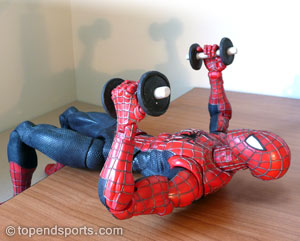This is a simple indirect test that is used to estimate the predominant muscle fiber type - slow twitch or fast twitch. It is interesting for athletes to know the composition of their muscle fibers. If they are primarily a strength or speed athlete, they want fast twitch fibers. For endurance athletes, more slow twitch fibers is optimal. This test does not replace an actual muscle fiber composition test, which would be more accurate but involves an invasive muscle biopsy and more sophisticated analysis.
purpose: to estimate the predominant muscle fiber type for any given muscle group.
equipment required: Free weights (barbells, dumbbells) or other gym equipment, assistant/spotter.
pre-test: Explain the test procedures to the subject. Perform screening of health risks and obtain informed consent. Prepare forms and record basic information such as age, height, body weight, gender and test conditions. Perform a standardized warm-up. See more details of pre-test procedures.
procedure: Determine your one repetition maximum (1RM) on a given exercise - a measure of the maximal weight a subject can lift with one repetition. Have a rest for 15 minutes. Then use 80% of your measured 1RM to perform as many repetitions as possible in a single attempt.
scoring: the maximum number of times the weight is correctly lifted is recorded. Use the values in the table below to determine the muscle fiber type based on the number of repetitions at 80% of 1RM (Pipes, 1994).
| number of reps at 80% | muscle fiber type |
|---|---|
| < 7 | > 50% fast twitch (FT) |
| 7 to 12 | equal proportion of fiber type |
| > 12 | > 50% slow twitch (ST) |
variations: There are two other protocols / assessments. These variations are replicated on many sites online, though no cited references can be found. One variation also uses 80% of your 1RM (Dr F. Hatfield Test), though the interpretation is different, and the other uses 85% 1RM (Charles Poliquin Test). As in the test above, the maximum number of reps at that level is recorded. The results for these variation are interpreted as follows.
| number of reps at 80% | muscle fiber type |
|---|---|
| < 7 | mostly fast twitch (FT) dominant |
| 7 or 8 | mixed fiber type |
| > 8 | slow twitch (ST) dominant |
| number of reps at 85% | muscle fiber type |
|---|---|
| < 5 | mostly fast twitch (FT) dominant |
| 5 | mixed fiber type |
| > 5 | slow twitch (ST) dominant |
advantages: the required equipment is readily available in most gymnasiums.
disadvantages: performing a maximum weight lift is only for advanced weight trainers. It is important to be experienced in the gym and have good technique before attempting this test. The results for muscle fiber type is specific to the muscle group tested, and may not apply to the other muscles of the body. As muscle groups are involved in the lifting techniques, the muscle fiber composition of individual muscles is not able to be determined using this test. 
comments: The test results will be specific to the equipment used and the technique allowed, so is best used for test-retest measures. Muscle fiber types can be broken down into two main types: slow twitch (Type I) muscle fibers and fast twitch (Type II) muscle fibers. Fast twitch fibers can be further categorized into Type IIa and Type IIb fibers.
reference: Pipes, T.V. (1994). Strength training and fiber types. Scholastic Coach, as referenced in Muscle Fiber Types and Training, by Jason R. Karp, Track Coach #155.
Similar Tests
- 1RM testing
- 1RM bench press test
- relative bench press test — using a % of body weight.
Related Pages
- Using girth measures to calculate muscle mass
- See also weightlifting techniques
- List of strength fitness tests


 Current Events
Current Events